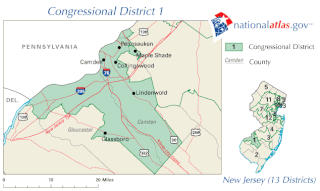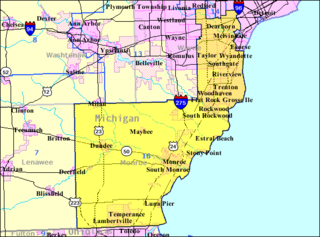| New Jersey's 14th congressional district | |
|---|---|
| Obsolete district | |
| Created | 1930 |
| Eliminated | 1990 |
| Years active | 1933–1993 |
New Jersey's 14th congressional district in the House of Representatives was eliminated after the 1990 census. As a result of the congressional apportionment performed after this census, New Jersey lost one seat and was reduced to thirteen seats in the House of Representatives.
New Jersey had gained a fourteenth seat following the 1930 census, and had as many as fifteen seats following the 1960 and 1970 censuses. After 1980, New Jersey was back down to fourteen seats.
In the 1980s, the district covered an area surrounding Jersey City, and was represented for seven terms by Frank Guarini. With the new lines drawn after the 1990 census, this seat was effectively renumbered as the 13th district.
The 14th congressional district (together with the 13th district) was created starting with the 73rd United States Congress in 1933, based on redistricting following the 1930 United States census.
Ohio's 19th congressional district was created following the 1830 census and was eliminated after the 2000 census. Between 1863 and 1880, it was represented by future US President James A. Garfield, who became the only sitting House member ever to be elected to the Presidency.
Ohio's at-large congressional district existed from 1803 to 1813, from 1913 to 1915, from 1933 to 1953 and from 1963 until 1967, when it was banned by the Voting Rights Act of 1965.

North Dakota's at-large congressional district is the sole congressional district for the state of North Dakota. Based on size, it is the eighth largest congressional district in the nation.
North Dakota's 1st congressional district is an obsolete congressional district in the state of North Dakota that existed from 1913 to 1933, and from 1963 to 1973.

New Jersey's 13th congressional district was a congressional district which was created for the 73rd United States Congress in 1933, based on redistricting following the 1930 United States census. It was last represented by Democrat Albio Sires when it was eliminated due to redistricting following the 2010 United States census. Most of this district became part of a newly redrawn 8th district in 2013.
New Jersey's 9th congressional district is represented in Congress by Democrat Bill Pascrell, who resides in Paterson. Congressman Pascrell was first elected in 1996 from the old 8th district, defeating incumbent William J. Martini. The 9th district consists largely of municipalities in Bergen County and Passaic County.

New Jersey's 1st congressional district is a congressional district in the U.S. state of New Jersey. The district, which includes Camden and South Jersey suburbs of Philadelphia, has been represented by Democrat Donald Norcross since November 2014. It is among the most reliably Democratic districts in New Jersey, as it is mainly made up of Democratic-dominated Camden County.

The 17th congressional district of Ohio is an obsolete congressional district last represented by Representative Tim Ryan.
Michigan's at-large congressional district may refer to a few different occasions when a statewide at-large district was used for elections to the United States House of Representatives from Michigan.
New Jersey's 15th congressional district in the House of Representatives was a relatively short-lived district that was created after the 1960 census and eliminated as a result of the redistricting cycle after the 1980 census.

Michigan's 16th congressional district is an obsolete United States congressional district in Michigan. It covered the communities of Dearborn, Downriver and Monroe County.
Michigan's 17th congressional district is an obsolete United States congressional district in Michigan. The first Representative to Congress elected from the 17th district, George Anthony Dondero, took office in 1933, after reapportionment due to the 1930 census. The district was dissolved following the 1990 census. The last Representative elected from the district, Sander M. Levin, was subsequently elected from the 12th district.
On three occasions in New York history, some members of the United States House of Representatives were elected statewide at-large. This was due to an increase of the number of representatives after the previous federal census, and the failure of the State Legislature to re-apportion the congressional districts in time for the next election.
Vermont's 2nd congressional district is an obsolete district. It was created upon Vermont's admission as the 14th state in 1791. It was eliminated after the 1930 census. Its last congressman was Ernest W. Gibson, who was redistricted into the at-large district.
Vermont's 5th congressional district is an obsolete district. It was created in 1821. It was eliminated after the 1840 census. Its last congressman was John Mattocks.
Vermont's 6th congressional district is an obsolete district.
Indiana's 13th congressional district was a congressional district for the United States House of Representatives in Indiana. It was eliminated as a result of the 1930 census. It was last represented by Samuel B. Pettengill who was redistricted into the 3rd district.
Wisconsin's 10th congressional district is a former congressional district of the United States House of Representatives in Wisconsin. It was created following the 1890 census, and was abolished after the 1970 census.
Wisconsin's 11th congressional district is a former congressional district of the United States House of Representatives in Wisconsin. It was created following the 1900 census, and was disbanded after the 1930 census. The district covered the far northern part of the state during its time of existence. All representatives who were ever elected to the seat were members of the Republican Party.